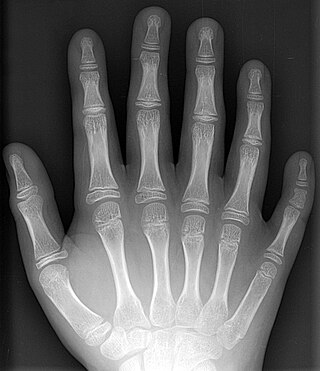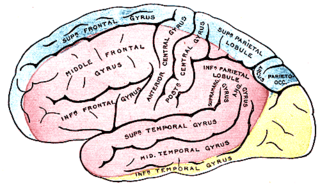Related Research Articles

Amputation is the removal of a limb by trauma, medical illness, or surgery. As a surgical measure, it is used to control pain or a disease process in the affected limb, such as malignancy or gangrene. In some cases, it is carried out on individuals as a preventive surgery for such problems. A special case is that of congenital amputation, a congenital disorder, where fetal limbs have been cut off by constrictive bands. In some countries, judicial amputation is currently used to punish people who commit crimes. Amputation has also been used as a tactic in war and acts of terrorism; it may also occur as a war injury. In some cultures and religions, minor amputations or mutilations are considered a ritual accomplishment. When done by a person, the person executing the amputation is an amputator. The oldest evidence of this practice comes from a skeleton found buried in Liang Tebo cave, East Kalimantan, Indonesian Borneo dating back to at least 31,000 years ago, where it was done when the amputee was a young child.
Body integrity dysphoria (BID), also referred to as body integrity identity disorder (BIID), amputee identity disorder or xenomelia, and formerly called apotemnophilia, is a rare mental disorder characterized by a desire to have a sensory or physical disability or feeling discomfort with being able-bodied, beginning in early adolescence and resulting in harmful consequences. BID appears to be related to somatoparaphrenia. People with this condition may refer to themselves as transabled.

A phantom limb is the sensation that an amputated or missing limb is still attached. It is a chronic condition which is often resistant to treatment. When the cut ends of sensory fibres are stimulated during thigh movements, the patient feels as if the sensation is arising from the non-existent limb. Sometimes the patient might feel pain in the non-existent limb. Approximately 80–100% of individuals with an amputation experience sensations in their amputated limb. However, only a small percentage will experience painful phantom limb sensation. These sensations are relatively common in amputees and usually resolve within two to three years without treatment. Research continues to explore the underlying mechanisms of phantom limb pain (PLP) and effective treatment options.

Vilayanur Subramanian Ramachandran is an Indian-American neuroscientist. He is known for his wide-ranging experiments and theories in behavioral neurology, including the invention of the mirror box. Ramachandran is a distinguished professor in UCSD's Department of Psychology, where he is the director of the Center for Brain and Cognition.

The parietal lobe is one of the four major lobes of the cerebral cortex in the brain of mammals. The parietal lobe is positioned above the temporal lobe and behind the frontal lobe and central sulcus.

The frontal lobe is the largest of the four major lobes of the brain in mammals, and is located at the front of each cerebral hemisphere. It is parted from the parietal lobe by a groove between tissues called the central sulcus and from the temporal lobe by a deeper groove called the lateral sulcus. The most anterior rounded part of the frontal lobe is known as the frontal pole, one of the three poles of the cerebrum.
Anosognosia is a condition in which a person with a disability is cognitively unaware of having it due to an underlying physical condition. Anosognosia results from physiological damage to brain structures, typically to the parietal lobe or a diffuse lesion on the fronto-temporal-parietal area in the right hemisphere, and is thus a neuropsychiatric disorder. A deficit of self-awareness, the term was first coined by the neurologist Joseph Babinski in 1914, in order to describe the unawareness of hemiplegia.

Sensory neurons, also known as afferent neurons, are neurons in the nervous system, that convert a specific type of stimulus, via their receptors, into action potentials or graded receptor potentials. This process is called sensory transduction. The cell bodies of the sensory neurons are located in the dorsal root ganglia of the spinal cord.

The angular gyrus is a region of the brain lying mainly in the posteroinferior region of the parietal lobe, occupying the posterior part of the inferior parietal lobule. It represents the Brodmann area 39.

Mirror therapy (MT) or mirror visual feedback (MVF) is a therapy for pain or disability that affects one side of the patient more than the other side. It was invented by Vilayanur S. Ramachandran to treat post-amputation patients who had phantom limb pain (PLP). Ramachandran created a visual illusion of two intact limbs by putting the patient's affected limb into a "mirror box," with a mirror down the center.
Phantom pain is a painful perception that an individual experiences relating to a limb or an organ that is not physically part of the body, either because it was removed or was never there in the first place.
Acalculia is an acquired impairment in which people have difficulty performing simple mathematical tasks, such as adding, subtracting, multiplying, and even simply stating which of two numbers is larger. Acalculia is distinguished from dyscalculia in that acalculia is acquired late in life due to neurological injury such as stroke, while dyscalculia is a specific developmental disorder first observed during the acquisition of mathematical knowledge. The name comes from the Greek a- meaning "not" and Latin calculare, which means "to count".
Utilization behavior (UB) is a type of neurobehavioral phenomena that involves someone grabbing objects in view and starting the 'appropriate' behavior associated with it at an 'inappropriate' time. Patients exhibiting utilization behavior have difficulty resisting the impulse to operate or manipulate objects which are in their visual field and within reach. Characteristics of UB include unintentional, unconscious actions triggered by the immediate environment. The unpreventable excessive behavior has been linked to lesions in the frontal lobe. UB has also been referred to as "bilateral magnetic apraxia" and "hypermetamorphosis".
Attraction to disability is a sexualised interest in the appearance, sensation and experience of disability. It may extend from normal human sexuality into a type of sexual fetishism. Sexologically, the pathological end of the attraction tends to be classified as a paraphilia. Other researchers have approached it as a form of identity disorder. The most common interests are towards amputations, prosthesis, and crutches. As a sexual fetish, attraction to disability is known as devotism, and those with the fetish are known as devotees.

Supernumerary body parts are most commonly a congenital disorder involving the growth of an additional part of the body and a deviation from the body plan. Body parts may be easily visible or hidden away, such as internal organs.

Foix–Chavany–Marie syndrome (FCMS), also known as bilateral opercular syndrome, is a neuropathological disorder characterized by paralysis of the facial, tongue, pharynx, and masticatory muscles of the mouth that aid in chewing. The disorder is primarily caused by thrombotic and embolic strokes, which cause a deficiency of oxygen in the brain. As a result, bilateral lesions may form in the junctions between the frontal lobe and temporal lobe, the parietal lobe and cortical lobe, or the subcortical region of the brain. FCMS may also arise from defects existing at birth that may be inherited or nonhereditary. Symptoms of FCMS can be present in a person of any age and it is diagnosed using automatic-voluntary dissociation assessment, psycholinguistic testing, neuropsychological testing, and brain scanning. Treatment for FCMS depends on the onset, as well as on the severity of symptoms, and it involves a multidisciplinary approach.

Middle cerebral artery syndrome is a condition whereby the blood supply from the middle cerebral artery (MCA) is restricted, leading to a reduction of the function of the portions of the brain supplied by that vessel: the lateral aspects of frontal, temporal and parietal lobes, the corona radiata, globus pallidus, caudate and putamen. The MCA is the most common site for the occurrence of ischemic stroke.
Amorphosynthesis, also called a hemi-sensory deficit, is a neuropsychological condition in which a patient experiences unilateral inattention to sensory input. This phenomenon is frequently associated with damage to the right cerebral hemisphere resulting in severe sensory deficits that are observed on the contralesional (left) side of the body. A right-sided deficit is less commonly observed and the effects are reported to be temporary and minor. Evidence suggests that the right cerebral hemisphere has a dominant role in attention and awareness to somatic sensations through ipsilateral and contralateral stimulation. In contrast, the left cerebral hemisphere is activated only by contralateral stimuli. Thus, the left and right cerebral hemispheres exhibit redundant processing to the right-side of the body and a lesion to the left cerebral hemisphere can be compensated by the ipsiversive processes of the right cerebral hemisphere. For this reason, right-sided amorphosynthesis is less often observed and is generally associated with bilateral lesions.
Supernumerary phantom limb is a condition where the affected individual believes they are receiving sensory information from limbs of the body that do not actually exist, and never have existed, in contradistinction to phantom limbs, which appear after an individual has had a limb removed from the body and still receives input from it.

Tactile hallucination is the false perception of tactile sensory input that creates a hallucinatory sensation of physical contact with an imaginary object. It is caused by the faulty integration of the tactile sensory neural signals generated in the spinal cord and the thalamus and sent to the primary somatosensory cortex (SI) and secondary somatosensory cortex (SII). Tactile hallucinations are recurrent symptoms of neurological diseases such as schizophrenia, Parkinson's disease, Ekbom's syndrome and delirium tremens. Patients who experience phantom limb pains also experience a type of tactile hallucination. Tactile hallucinations are also caused by drugs such as cocaine and alcohol.
References
- ↑ Callaway, Ewen. "Desire to amputate healthy limbs shows up in brain scans". New Scientist. Retrieved 2020-07-04.
- ↑ McGeoch, Paul D.; Brang, David; Song, Tao; Lee, Roland R.; Huang, Mingxiong; Ramachandran, V. S. (2011-12-01). "Xenomelia: a new right parietal lobe syndrome". Journal of Neurology, Neurosurgery & Psychiatry. 82 (12): 1314–1319. doi:10.1136/jnnp-2011-300224. ISSN 0022-3050. PMID 21693632. S2CID 18965282.
- ↑ "Phantom Finger Points To Secrets In The Human Brain". NPR.org. Retrieved 2020-07-04.
- ↑ McGeoch, Paul D.; Ramachandran, V. S. (2012-04-01). "The appearance of new phantom fingers post-amputation in a phocomelus". Neurocase. 18 (2): 95–97. doi:10.1080/13554794.2011.556128. ISSN 1355-4794. PMID 21598175. S2CID 22522410.
- ↑ Taylor, Charlie. "Belfast medtech start-up Neurovalens raises £4.6m for weight-loss headband". The Irish Times. Retrieved 2020-07-04.
- ↑ McDonnell, Francess. "Belfast tech firm to launch weight-loss device". The Irish Times. Retrieved 2020-07-04.